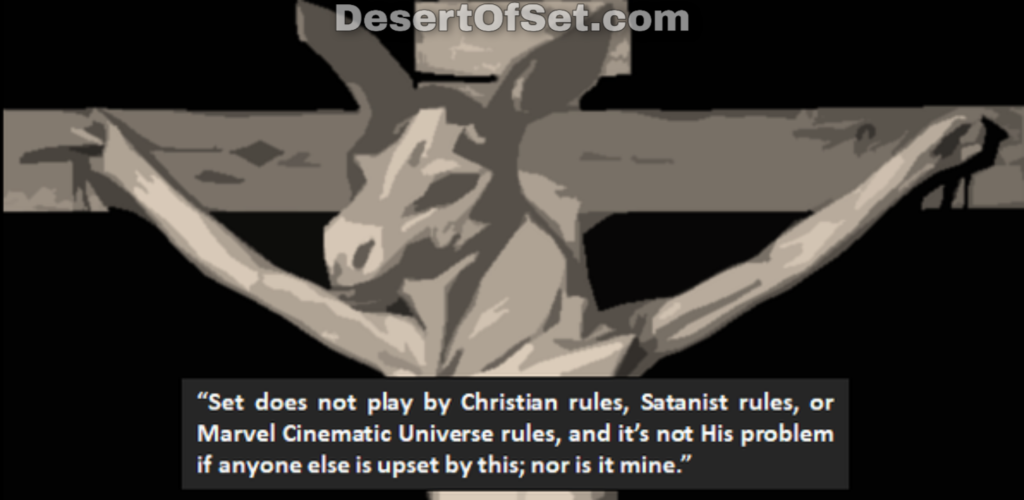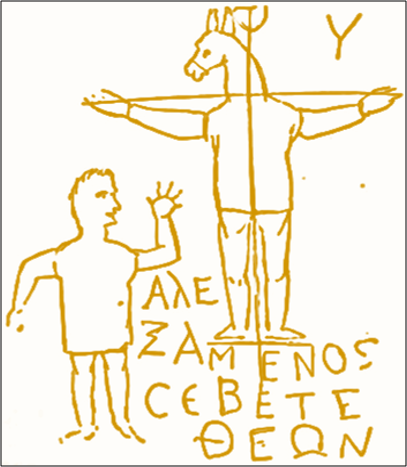Set does not play by Christian rules, Satanist rules, or Marvel Cinematic Universe rules, and neither do Setians.

Growing up in Protestant America during the 20th century, I was trained to view any divinity apart from the biblical God as either a “false idol” or “the devil.” Even being raised by nominally Christian parents, it was impossible to escape such mental conditioning. This really became an issue for me when I came to Set in 1997. As His presence grew stronger and I realized I was a Setian, people told me everything about this was “demonic.” Some were willing to accept that my God doesn’t really fit into that scheme, and that He marches to a completely different theological beat. But I wasn’t so great at explaining these things back then, and even the people who listened to me weren’t getting the full story.
The people who weren’t willing to listen didn’t care, concluding I was simply insane, possessed, or both. It especially hurt when I encountered this attitude from other Pagans, and it made me oversensitive to the subjects of Christ and Satan for quite some time. I don’t feel too ashamed about this, as there was not exactly a “surplus” of mature Setian adults for me to learn from as a kid. I had to learn how to conduct myself on my own; and while it was rough, I think I turned out OK. I know there are others who have dealt with similar growing pains too, and I just want to say you are not alone.
Since “khepering” from the rowdy Typhonian foal I once was to the generally grouchy but more agreeable jackass I am today, I gained access to better literature on Set and learned some things that mellowed me out on this stuff. And I met other people who really did learn to accept me as I am, including not only other Setians, but Pagans, atheists, agnostics, and even some born-again Christians too. I even re-learned to enjoy Alice Cooper after discovering he’s an evangelical! Just what the hell (or heaven) happened? Well, first I learned of Set’s appearances in the Greek magical papyri. He is not only called Typhon or Seth in these texts, but also things like Ablanathanalba, Lerthemino, and Kolchoi Tontonton. No one really knows what most of these “barbarous names” or voces magicae actually mean; but a few have been translated, including two that are important to this discussion: Iao Sabaoth and Aberamentho.
Iao Sabaoth is a Hellenized corruption of a name for the Hebrew God, who was identified with Set by Greco-Egyptian syncretists. In the earliest years CE, the polytheist world reacted to both Jehovah and Set the same way the monotheist world reacts to Satan today. Some thought the God of Israel is really Big Red in disguise, and that Jews were actually “descendants” of Set. As far as most people knew or cared, Setians and Jews were both serving an evil God that demands we have sex with donkeys, cannibalize kids, and poison local wells to spread plagues. This is one of the earliest records of blood libel, or the accusation that a minority community is committing ritualized terrorism and/or child or animal abuse. This trope shaped not only the European witch hysterias, but also contemporary urban folklore like the Satanic Panic. Conspiracy lovers still believe there is a global cabal of Satan-worshiping witches engaging in unspeakable acts, and Jews and Pagans are both still conflated with this fictitious anti-religion today.
Aberamentho means “Lord of the Waters,” which likely refers to Set sublimating and controlling the Chaos Serpent. Yet it also appears in the Pistis Sophia—a Gnostic text that was contemporary to the Greek magical papyri and the New Testament—as a name for Christ. It likely refers to St. John’s belief in Jesus as the Logos, the mystical Word, which was with IHVH before Genesis begins. In a similar way, I feel that Set and the other Netjeru were all with Ra at the Dawn of Time. I think Set is the aspect of Ra that empowered them to kheper in the first place, starting the cosmic chain of transformations that is Creation. Two savior Gods who both pre-existed the universe, and who are both vital to how the cosmos functions.

The Alexamenos Graffito
And then there’s the Alexamenos graffito, scrawled on a wall to shame a Roman soldier for being Christian. It shows the poor guy praying to a cruciform donkey-headed Jesus, and it’s the earliest known image of the God at present. Christians had to meet for worship in spooky catacombs at night for fear of literally being thrown to the lions. Their polytheist neighbors saw them as lunatics worshiping an executed cult leader, and the idea of the Eucharist led to accusations of cannibalism. While the Alexamenos image does not refer to Set directly, He is implicit in the form of Christ’s equine head. Donkeys are sacred to Set, and they were maligned, abused, and murdered for this very reason at the time. So to draw someone with a donkey’s head was to vilify them, not unlike drawing someone with goat horns today.
The graffito spooked me when I first saw it, for I had seen a vision that closely resembled it during one of my earliest Sabbat rituals back in 1998. I would stay up late on Friday nights, quietly invoking Set, playing some metal for Him and talking to Him through the night. Sometimes I meditated, and on one occasion, I saw Big Red in a loincloth, being crucified by an angry mob. He had a Sha’s head, not a donkey’s; but He was being nailed to a cross just the same. For years, I thought this was just some brief artistic fancy; but while the Alexamenos graffito is not an exact duplicate of this vision, the resemblance was immediate and very shocking to me when I finally saw it in late 2007. I remember having to sit down, in fact, and someone asked me if anything was wrong (“No man, my head is just exploding!!”).
There have even been times when Set and Jesus seemed to intersect for me in bizarre ways. My mother-in-law was a deeply religious born-again Christian, and she had trouble making heads or tails of my belief system when we first met. But years later, when she was hospitalized for an injury, she had an experience with Set in her hospital bed. After that point, she and I shared a special bond where it was like Set and Jesus could be “buddies” through us. When she passed away in 2015, my Ma-in-Law asked me to pray for her; I told her to go with Jesus to his heaven, and I asked Set to clear her path of all obstacles. It was not exactly a pleasant event to experience, but it was very sacred to be sure.
I am not a fan of how Set is usually treated in most Satanist literature I’ve seen. The scholarship is usually both sloppy and full of confirmation bias; every effort is made to “prove” that Satan “came from” Set, and nothing is ever mentioned about how Set was also identified with Yahweh and Christ. I’ve had people get really upset at me for even mentioning these things, as well. They don’t want Set to be a multifaceted God who can get along with either Jesus and/or Satan whenever He might feel like it; they just want Him to be a fallen angel in Egyptian drag. But this overly dualist mindset is completely alien to the Egyptian way of thinking. Set does not play by Christian rules, Satanist rules, or Marvel Cinematic Universe rules, and it’s not His problem if anyone else is upset by this; nor is it mine.
